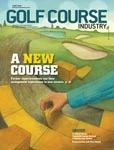The good news thus far in 2009 is that the weather has cooperated, at least here in the Great Lakes and broader Northeast. The last thing anyone needs is a bunch of soggy weekends and rained-out events. So, at least Mother Nature doesn’t hate us as much as the banks, Congress and the media.
The bad news is that the shakedown cruise continues. A still relatively small percentage of courses are closing, at least temporarily, rather than continuing to operate at a loss. Nearly everyone is managing back to some extent, most notably in terms of labor costs and deferred capital spending and projects.
Most facilities are slogging along. Occasionally, you even hear of a few that are still kicking butt through some combination of filling the right local niche, marketing creatively and sheer hard work. In short, it could be worse. But many people are using a broad brush to paint a much darker picture than really exists. Given that, I’d thought I pay tribute to one of my favorite TV shows, “Mythbusters,” by examining which of the legends currently floating around our business are confirmed, plausible or just plain busted.
Myth No. 1: The downturn will bring on the demise of the “executive
superintendent” concept.
I’ve talked with “knowledgeable” golfers who say some high-end superintendents who’ve had more than ample staff and budgets will be most at risk because they don’t actually know how to maintain their own courses. Somehow, they’ve risen through the ranks because of their ability to B.S. with members and throw money at problems.
The premise is that those guys won’t be able to survive in the new market because, due to staff downsizing and budget reductions, they won’t have a gaggle of assistants to grow grass for them or a pile of cash to buy every new toy that comes along. They’ll never be able to survive in the real world.
Here’s how you test the premise of this urban legend: scratch almost any “managing” superintendent and they’ll still bleed green. Name me one of these guys who would rather be sitting in a board meeting or glad-handing with members instead of being out on the course doing what they love. Most have been pigeonholed into these positions out of necessity, not desire. If necessity requires them to pull off their neckties and climb back onto a mower or jump into a muddy hole to fix a busted line, most will jump at the opportunity. They’re problem-solvers and turfheads, not empty suits. Myth: Busted.
Myth No. 2: Economic pressure will create an opportunity for superintendents to convince golfers that “brown is beautiful.”
In other words, the silver lining is that players will understand what’s going on and accept less pristine conditions. Therefore, we can be both more environmentally friendly and create those famed fast-and-firm conditions that some low-handicappers claim are more important than aesthetics or receptive greens.
This one’s a variation on the legend that, with education, golfers will embrace less-intensive maintenance for the sake of the game. Here’s how we test this one: Take a photo of a perfectly maintained golf hole and digitally insert some brown patches. Then, put both pictures in front of 100 golfers and ask them which course they’d prefer to play. If even three of them asked, “How firm are the fairways?” before choosing the pretty green one, I’d be shocked.
Myth: Busted, but plausible at a few clubs dominated by low-handicappers.
Myth No. 3: The biggest problems will come after the season’s over.
The idea is that courses, particularly in cool-season areas, will wait until after the season to axe support staff. I’ve had more than a few e-mails from assistants around the country who sense that they’ll be sent packing after Labor Day.
The argument is that ownership will decide to shift to seasonal rather than full-time positions for more staff, including assistants, technicians and mechanics. The test here – aside from administering polygraphs to the general manager or owner – is to look your boss right in the eye and ask him/her the odds of you still having a full-time job come October. It’s a gutsy and imperfect experiment, but it’s the only way to at least test the premise. Myth: All too plausible and likely to be confirmed this October.
Myth No. 4: Private clubs are the most at risk in the current economy.
Clubs are all going to fail eventually, right? Wrong. Well-managed clubs that adapt to the new needs of the modern member will do fine. The recession is, in some cases, accelerating the decline of clubs that refused to change with the times, made horrible financing decisions or failed to be creative.
Far more at risk (besides stand-alone, high-end daily fees with atrocious debt service) are government-owned courses. At a time when local governments are struggling to keep cops on the beat, losing hundreds of thousands annually on a muni just isn’t politically palatable. Myth: Busted.
Myth No. 5: Jones watches too much TV and keeps using shows as a
platform for his columns.
Myth: Confirmed. GCI

Explore the June 2009 Issue
Check out more from this issue and find your next story to read.
Latest from Golf Course Industry
- Editor’s notebook: Green Start Academy 2024
- USGA focuses on inclusion, sustainability in 2024
- Greens with Envy 65: Carolina on our mind
- Five Iron Golf expands into Minnesota
- Global sports group 54 invests in Turfgrass
- Hawaii's Mauna Kea Golf Course announces reopening
- Georgia GCSA honors superintendent of the year
- Reel Turf Techs: Alex Tessman





